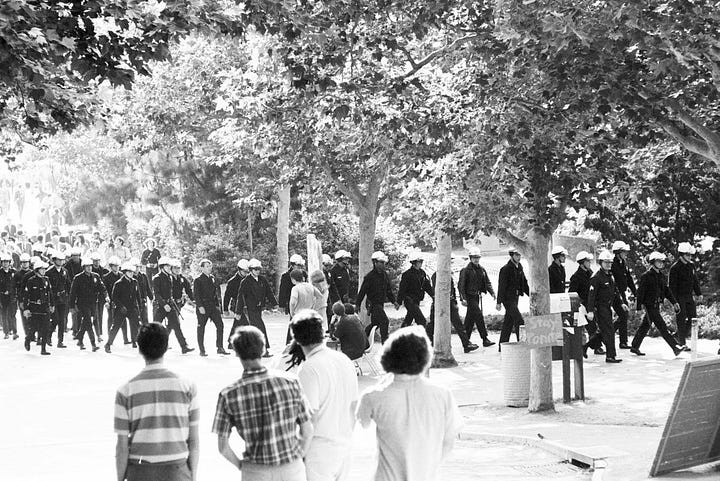Cops on campus, then and now. The militarized response to protest has become pervasive.


Last week a bunch of right-wingers, which included some white supremacist and ironically anti-semitic gangs, joined with pro-Israeli thugs, and attacked the encampment at the University of California at Los Angeles.
University police and officers from the LAPD stood down and did nothing to stop the thugs. They then used the violence of the gangs as an excuse to break up the encampment.
Calling the cops to break up peaceful protest on campus is not new for UCLA.
I personally recall when the LAPD was called to the campus in response to students and others - we were called “outside agitators” back then too - protested then Governor Ronald Reagan’s ending what was essentially free tuition at the state’s public universities.
Tuition further limited the number of Black and Brown students who could attend California’s public colleges and universities.
In his 1966 campaign for California governor, Republican Ronald Reagan promised to "to clean up the mess at Berkeley." Reagan was referring to the youth revolt, not just at the University of California, Berkeley, but on college campuses throughout the state.
I recall a 1966 campaign speech when Reagan declared that the Movement on campuses had transcended legitimate protest, with the actions of "beatniks, radicals and filthy speech advocates" having become more to do "with rioting, with anarchy" than "academic freedom."
Six months after Reagan took office as governor in 1967 he wrote a letter to Glenn Dumke, the chancellor of San Francisco State College, one of California’s largest public institutions. Dumke, like many of the college and university administrators today, was a staunch opponent of protesting students and faculty.
In his letter to Dumke, Reagan criticized the movement on campuses. He condemned "these people & this trash" on campuses as well as "the excuse of academic freedom & freedom of expression" in allowing protests and demonstrations to go on.
"We wouldn’t tolerate this kind of language in front of our families," Reagan wrote of the protests. He urged Dumke to "lay down some rules of conduct," promising that "you’d have all the backing I could give you."
It’s kind of weird to read now the university referring approvingly of student protest in the sixties while calling the cops on the protests today.
The following is from a current UCLA alumni brochure:
In 1969, Charles E. Young, M.A. ’57, Ph.D. ’60 became chancellor, the youngest ever to run a major university and the first UCLA alumnus in the role. Young would lead UCLA through the next three decades. As his term began, the UC Regents held a meeting at UCLA. More than 1,500 students gathered to protest the Vietnam War, with students calling for a dialogue between Chancellor Young and activists. In an unprecedented move, more than 100 officers were brought on campus to disperse the protests. A few days later, 1,200 students staged a sit-in in Murphy Hall, protesting the use of National Guard troops at UC Berkeley.
Students protesting the Vietnam War.
Protests began at UCLA in 1967 as students opposed to the war in Vietnam objected to Dow Chemicals recruiting graduates on campus. Dow produced napalm, a chemical agent used in the war. As the war progressed, demonstrations continued, increasing in size and intensity. Across campus students staged anti-war protests and sit-ins, and demonstrated to remove the ROTC from campus and for equal representation for underrepresented students. The turmoil of the late 1960s would carry over into the next decade, presenting the university with opportunities for more growth and change.
How different the attitude of campus administrators now as they aim their fire at those protesting Israeli genocide and the U.S. support for it.
The level of police violence on May 2nd was nothing like any observers have witnessed before.
Not even in the sixties.
Jack Fukushima, 28, a UCLA medical student and volunteer medic, told Kaiser Health News:
…he witnessed a police officer shoot at least two protesters with less lethal projectiles, including a man who collapsed after being hit “square in the chest.” Fukushima said he and other medics escorted the stunned man to the medical tent then returned to the front lines to look for more injured.
“It did really feel like a war,” Fukushima said. “To be met with such police brutality was so disheartening.”
Stepped up police violence and militarization in response to protest has become pervasive.
Kaiser Health News reported:
In recent years, police across the U.S. have repeatedly fired these weapons at protesters, with virtually no overarching standards governing their use or safety. Cities have spent millions to settle lawsuits from the injured. Some of the wounded have never been the same.
During the nationwide protests following the police killing of George Floyd in 2020, at least 60 protesters sustained serious injuries — including blinding and a broken jaw — from being shot with these projectiles, sometimes in apparent violations of police department policies, according to a joint investigation by KFF Health News and USA Today.
“They’re called less lethal for a reason,” said Jim Bueermann, a former police chief of Redlands, California, who now leads the Future Policing Institute. “They can kill you.”




